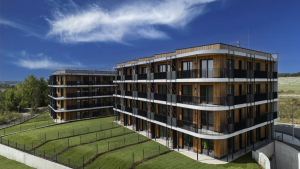
According to Cushman & Wakefield, the Polish industrial market saw a marked upturn in occupier activity in the second quarter of 2024, reporting the highest leasing volume in Europe. In addition, Poland’s total industrial stock is poised to soon surpass the 35 million sqm mark.
Take-up: Poland sees the strongest demand in Europe
The first half of 2024 ended with total take-up at nearly 2.7 million sqm, up by as much as 22% year-on-year.
"In the three months to June 2024, tenants leased 1.76 million sqm of warehouse space, more than making up for the poor performance in the first quarter. This marked the best result for warehouse take-up in Europe and the second time when Poland outpaced Germany for quarterly leasing volumes. It is also notable that large leases for 20,000-130,000 sqm accounted for 56% of the second quarter total", comments Damian Kołata, Partner, Head of Industrial & Logistics/E-Commerce CEE, Cushman & Wakefield.
The three largest leases of the second quarter were recorded in Wrocław and Bydgoszcz-Toruń. In the Wrocław region, an international e-commerce platform took an additional 126,000 sqm while LX Pantos renewed and expanded its lease to 100,000 sqm. The third transaction saw LPP Logistics lease 104,000 sqm of warehouse space near Bydgoszcz for online order fulfilment.
Similarly to last year, new leases and expansions totalling 1.66 million sqm accounted for around 60% of the leasing volume (up by 24% year-on-year), with the remaining 40% transacted under renewed contracts.
"The breakdown of net take-up by sector reveals significant changes: retailers and e-commerce companies raised their share of net take-up to 34% while logistics providers saw theirs fall from 36% in the first half of 2023 to the current 22%. Looking ahead, demand is expected to be driven in the long term by the continued growth of e-commerce, the increasing adoption of ESG strategies and thereby the flight to quality, as well as nearshoring trends", adds Adrian Semaan, Market Analyst, Cushman & Wakefield.
Supply: A marked decline in speculative construction
In June 2024, Poland’s total industrial stock stood at 33.52 million sqm, up by 9% year-on-year.
"The Polish industrial market continues to enjoy brisk expansion with 1.64 million sqm of modern warehouse space delivered in the first half of 2024. A similar volume is scheduled for completion in the second half of this year, signifying that Poland’s total industrial stock is firmly on course to exceed 35 million sqm in the near future", says Damian Kołata.
New supply in the second quarter of 2024 reached almost 786,000 sqm, of which 44% remained vacant. This pushed warehouse availability up to 2.80 million sqm at the end of June. The overall vacancy rate edged up to 8.3% (up by 1.6 pp y-o-y and 0.1 pp q-o-q) - its highest level since September 2020 (8.5%). The largest upward movements in vacancy levels in the last 12 months were recorded in Lubuskie (up by 8.6 pp to 19.3%), Pomerania (up by 5.6 pp to 7.1%), Lesser Poland (up by 4.9 pp to 6.1%) and Łódzkie (up by 3.1 pp to 10.8%). Regions reporting negative growth were Western Pomerania (down by 3.4 pp to 4.0%), Silesia (down by 1.9 pp to 5.9%) and Greater Poland (down by 1.0 pp to 5.9%).
"Development activity slackened slightly, which - coupled with a sharp decline in speculative construction - is likely to push vacancy rates down in the next 9-12 months. In the second quarter of 2024, work began on the construction of approximately 460,000 sqm of warehouse space, of which only 184,000 sqm was being built speculatively. This brought Poland’s total development pipeline to 1.99 million sqm at the end of June", adds Adrian Semaan.
Of all the regions, Lower Silesia is the hot spot for construction activity with 568,000 sqm underway, of which as much as 40% is being developed for an international e-commerce platform in P3 Wrocław in Kąty Wrocławskie. The second quarter of 2024 saw the highest number of new starts in Silesia (156,000 sqm, of which 81,000 sqm is speculative space) and Mazovia (146,000 sqm, including 67,000 sqm of speculative projects).
Rents: Stabilization with effective rents under slight downward pressure
In the first half of 2024, monthly headline rents remained flat at EUR 3.60–6.50 per sqm for big-box warehouses and at EUR 5.00–7.50 per sqm for SBU/City Logistics projects. With financial incentives such as rent-free periods or space adaptation contributions offered to tenants, effective rents can be lower than headline rental rates by a maximum of 15-25%.
Labour market: The industrial sector is filling vacancies
In the second quarter of 2024, the highest labour rates for production workers in terms of basic remuneration were recorded in Poland’s southern provinces (Lower Silesia, Lesser Poland and Silesia) - they stood at more than PLN 28 per hour.
"More than 20% of companies across Poland offer production workers basic hourly rates in excess of PLN 28, with over 22% providing the most common rate of PLN 26 per hour. Less than 2% of employers offer PLN 34-36 per hour. It is worth noting that more than 84% of workers in this sector are Polish while Ukrainian citizens account for nearly 14% of the workforce, being the second-largest group by nationality", comments Dagmara Żuromska, Strategic Business Development Senior Manager, Randstad Polska.
The percentage of companies conducting recruitment rose significantly compared with the first quarter of 2024, with the key driver still being the need to fill vacancies resulting from employee turnover. Recruitment processes are much more often initiated by large employers, particularly in such sectors as retail, logistics and construction; and according to respondents, the more there are such processes, the more difficult it will be to find suitable job candidates.
"Employee turnover is obviously impacted by overall job satisfaction. It is worth noting that job satisfaction levels have slightly improved in transport, logistics and manufacturing. 80% of transport and logistics employees and 74% of manufacturing workers are either very or quite satisfied with their current jobs and nearly half of those working in these sectors are not looking for new employment at all", adds Dagmara Żuromska, Randstad.



